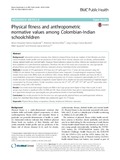Mostrar el registro sencillo del ítem
Physical fitness and anthropometric normative values among Colombian-Indian schoolchildren
| dc.creator | Ramos Sepúlveda, Jeison Alexander | es_ES |
| dc.creator | Ramírez Vélez, Robinson | es_ES |
| dc.creator | Correa Bautista, Jorge Enrique | es_ES |
| dc.creator | Izquierdo Redín, Mikel | es_ES |
| dc.creator | García Hermoso, Antonio | es_ES |
| dc.date.accessioned | 2018-08-31T08:08:01Z | |
| dc.date.available | 2018-08-31T08:08:01Z | |
| dc.date.issued | 2016 | |
| dc.identifier.issn | 1471-2458 | |
| dc.identifier.uri | https://hdl.handle.net/2454/30358 | |
| dc.description.abstract | Background: Substantial evidence indicates that children’s physical fitness levels are markers of their lifestyles and their cardio-metabolic health profile and are predictors of the future risk of chronic diseases such as obesity, cardiometabolic disease, skeletal health and mental health. However, fitness reference values for ethnic children and adolescents have not been published in a Latin-American population. Therefore, the aim of the study was to provide sex- and age-specific physical fitness and anthropometric reference standards among Colombian-Indian schoolchildren. Methods: A sample of 576 participants (319 boys and 257 girls) aged 10 to 17 years old was assessed using the FUPRECOL test battery. Four components of physical fitness were measured: 1) morphological component: height, weight, body mass index (BMI), waist circumference (WC), triceps skinfold, subscapular skinfold, and body fat (%); 2) musculoskeletal component: handgrip and standing long jump test; 3) motor component: speed/agility test (4 × 10 m shuttle run); and 4) cardiorespiratory component: course-navette 20 m, shuttle run test and estimation of maximal oxygen consumption by VO2max indirect. Centile smoothed curves for the 3rd, 10th, 25th, 50th, 75th, 90th and 97th percentiles were calculated using Cole’s LMSmethod. Results: Our results show that weight, height and BMI in each age group were higher in boys than in girls. In each groups, age showed a significant effect for BMI and WC. Boys showed better than girls in cardiorespiratory fitness, lowerand upper-limb strength and speed/agility and girls performed better in low back flexibility. Conclusion: Our results provide for the first time sex- and age-specific physical fitness and anthropometric reference values for Colombian Nasa Indian children and adolescents aged 10–17.9 years. | en |
| dc.description.sponsorship | The “Fuprecol Study” was carried out with the financial support of Instituto Colombiano para el Desarrollo de la Ciencia y la Tecnología “Francisco José de Caldas” COLCIENCIAS (Contract N° 671–2014 Code 122265743978). | en |
| dc.format.extent | 15 p. | |
| dc.format.mimetype | application/pdf | en |
| dc.language.iso | eng | en |
| dc.publisher | BioMed Central | en |
| dc.relation.ispartof | BMC Public Health (2016) 16:962 | en |
| dc.rights | © 2016 The Author(s). This article is distributed under the terms of the Creative Commons Attribution 4.0 International License, which permits unrestricted use, distribution, and reproduction in any medium, provided you give appropriate credit to the original author(s) and the source, provide a link to the Creative Commons license, and indicate if changes were made. The Creative Commons Public Domain Dedication waiver (http://creativecommons.org/publicdomain/zero/1.0/) applies to the data made available in this article, unless otherwise stated. | en |
| dc.rights.uri | https://creativecommons.org/licenses/by/4.0/ | |
| dc.subject | Physical fitness | en |
| dc.subject | Body composition | en |
| dc.subject | Obesity | en |
| dc.subject | Adolescent | en |
| dc.subject | Reference standards | en |
| dc.title | Physical fitness and anthropometric normative values among Colombian-Indian schoolchildren | en |
| dc.type | info:eu-repo/semantics/article | en |
| dc.type | Artículo / Artikulua | es |
| dc.contributor.department | Ciencias de la Salud | es_ES |
| dc.contributor.department | Osasun Zientziak | eu |
| dc.rights.accessRights | info:eu-repo/semantics/openAccess | en |
| dc.rights.accessRights | Acceso abierto / Sarbide irekia | es |
| dc.identifier.doi | 10.1186/s12889-016-3652-2 | |
| dc.relation.publisherversion | https://doi.org/10.1186/s12889-016-3652-2 | |
| dc.type.version | info:eu-repo/semantics/publishedVersion | en |
| dc.type.version | Versión publicada / Argitaratu den bertsioa | es |
Ficheros en el ítem
Este ítem aparece en la(s) siguiente(s) colección(ones)
La licencia del ítem se describe como © 2016 The Author(s). This article is distributed under the terms of the Creative Commons Attribution 4.0
International License, which permits unrestricted use, distribution, and
reproduction in any medium, provided you give appropriate credit to the original author(s) and the source, provide a link to
the Creative Commons license, and indicate if changes were made. The Creative Commons Public Domain Dedication waiver
(http://creativecommons.org/publicdomain/zero/1.0/) applies to the data made available in this article, unless otherwise stated.



